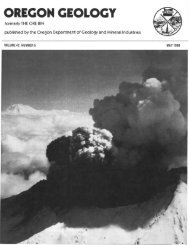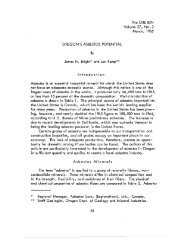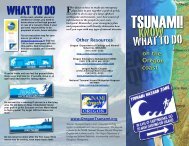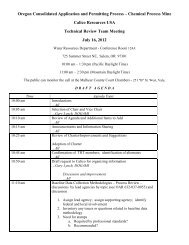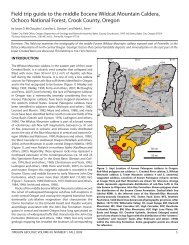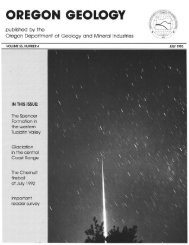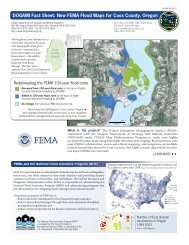What is a tsunami? - Oregon Department of Geology and Mineral ...
What is a tsunami? - Oregon Department of Geology and Mineral ...
What is a tsunami? - Oregon Department of Geology and Mineral ...
You also want an ePaper? Increase the reach of your titles
YUMPU automatically turns print PDFs into web optimized ePapers that Google loves.
what to do<br />
At the coast, whether you are a<br />
resident or v<strong>is</strong>itor, you need to<br />
know where to find high ground<br />
in case <strong>of</strong> a <strong>tsunami</strong>. Make it your<br />
personal responsibility to be<br />
prepared: at work, home <strong>and</strong> play.<br />
Get an evacuation map for your<br />
area or go online to<br />
<strong>Oregon</strong>Tsunami.org to find one.<br />
Talk to local emergency <strong>of</strong>ficials<br />
(fire, police, Red Cross) about<br />
evacuation routes <strong>and</strong> assembly<br />
areas.<br />
If you’re inside <strong>and</strong> you feel the ground shake,<br />
drop, cover <strong>and</strong> hold on. If outside, move to an<br />
open area <strong>and</strong> watch for falling objects.<br />
F<br />
or ideas on how to make an emergency<br />
plan, how to put together a grab & go kit,<br />
<strong>and</strong> what to do in case <strong>of</strong> a large <strong>of</strong>fshore<br />
earthquake <strong>and</strong> <strong>tsunami</strong>, your best source <strong>of</strong><br />
information <strong>is</strong> the people in your own<br />
backyard. Remember, your emergency plan<br />
<strong>and</strong> preparations will directly determine how<br />
well you cope with any type <strong>of</strong> natural d<strong>is</strong>aster.<br />
Other Resources<br />
<strong>Oregon</strong> <strong>Department</strong> <strong>of</strong> <strong>Geology</strong> <strong>and</strong> <strong>Mineral</strong><br />
Industries (DOGAMI)<br />
(971) 673-1555<br />
http://www.<strong>Oregon</strong>Tsunami.org<br />
<strong>Oregon</strong> Emergency Management (OEM)<br />
(503) 378-2911 ext. 22237<br />
http://www.oregon.gov/OMD/OEM<br />
<strong>Oregon</strong> Pacific Chapter<br />
<strong>of</strong> the American Red Cross (ARC)<br />
(541) 673-3255<br />
www.oregonpacific.redcross.org<br />
National Tsunami Hazard Mitigation Program<br />
(NTHMP)<br />
http://nthmp.<strong>tsunami</strong>.gov/<br />
TSUNAMI!<br />
know<br />
what to do<br />
on the<br />
<strong>Oregon</strong><br />
coast<br />
Do not wait for a warning if you are in a low lying<br />
area. Do not pack or delay. Immediately locate<br />
your grab & go kit. Evacuate on foot. Move inl<strong>and</strong><br />
to high ground. Try to get 100 feet above sea<br />
level.<br />
Do not return to shore after the first wave. More<br />
waves may be coming, even many hours later.<br />
www.<strong>Oregon</strong>Tsunami.org<br />
Tsunami Outreach <strong>Oregon</strong> <strong>is</strong> local communities working<br />
together on earthquake <strong>and</strong> <strong>tsunami</strong> preparedness. The program<br />
<strong>is</strong> funded by the NOAA National Tsunami Hazard Mitigation<br />
Program <strong>and</strong> <strong>is</strong> admin<strong>is</strong>tered by The <strong>Oregon</strong> <strong>Department</strong> <strong>of</strong><br />
<strong>Geology</strong> <strong>and</strong> <strong>Mineral</strong> Industries, in partnership with <strong>Oregon</strong><br />
Emergency Management.
<strong>What</strong> <strong>is</strong> a<br />
<strong>tsunami</strong>?<br />
A <strong>tsunami</strong> (su-NAH-mee) <strong>is</strong> a<br />
series <strong>of</strong> sea waves usually caused<br />
by the sudden movement <strong>of</strong> the<br />
ocean floor because <strong>of</strong> a large<br />
undersea earthquake. As tsunam<strong>is</strong><br />
enter shallow water near l<strong>and</strong>, they<br />
increase in height <strong>and</strong> can cause great<br />
loss <strong>of</strong> life <strong>and</strong> property damage.<br />
People on open beaches, low-lying areas, by<br />
bays or tidal flats, <strong>and</strong> near mouths <strong>of</strong> rivers<br />
draining into the ocean are at greatest r<strong>is</strong>k from<br />
a <strong>tsunami</strong> <strong>and</strong> may have little time after a large<br />
earthquake to move to high ground.<br />
Tsunam<strong>is</strong> can<br />
happen at any time<br />
In March 2011 on a Friday afternoon at<br />
2:46pm, a magnitude 9 megathrust earthquake<br />
occurred 80 miles <strong>of</strong>f the coast <strong>of</strong> Japan.<br />
D<strong>is</strong>placed ocean <strong>tsunami</strong> waves began<br />
inundating the coast within 15 minutes, with<br />
waves ranging up to 35 feet high <strong>and</strong> reaching<br />
run-up elevations <strong>of</strong> 135 feet. 15,845 people<br />
died <strong>and</strong> 3,380 are still m<strong>is</strong>sing. The same thing<br />
could happen on our coast at any time <strong>and</strong> be<br />
just as deadly.<br />
Learn about the <strong>tsunami</strong><br />
warning system <strong>and</strong> where<br />
to find evacuation maps at:<br />
www.<strong>Oregon</strong>Tsunami.org<br />
2 types <strong>of</strong> tsunam<strong>is</strong>:<br />
know the difference<br />
A DISTANT TSUNAMI, caused by a large<br />
undersea earthquake, comes from across the<br />
ocean <strong>and</strong> will take at least a few hours to<br />
come ashore. There will usually be plenty <strong>of</strong><br />
time for an <strong>of</strong>ficial warning <strong>and</strong> evacuation, if<br />
necessary. A NOAA weather radio <strong>is</strong> the best<br />
way to find out what <strong>is</strong> happening. Many communities also<br />
have sirens <strong>and</strong> mass calling systems to alert the public.<br />
Designated local radio <strong>and</strong> TV stations will also have<br />
information through their Emergency Alert System (EAS).<br />
A LOCAL TSUNAMI comes ashore within 10 to 20<br />
minutes after a nearby <strong>of</strong>fshore earthquake that you will<br />
feel. A local <strong>tsunami</strong> can be very destructive <strong>and</strong> fatal. Do<br />
not wait for a warning. If you are near the ocean, you<br />
need to head to high ground as quickly as possible. Your<br />
only warning will be the ground shaking. It’s important to<br />
have a grab & go kit <strong>and</strong> know the evacuation routes <strong>and</strong><br />
assembly areas in your community.<br />
See more at: www.<strong>Oregon</strong>Tsunami.org<br />
Learn the facts, make a plan<br />
<strong>and</strong> get some help<br />
Underst<strong>and</strong>ing what could happen in a great earthquake <strong>and</strong> <strong>tsunami</strong> <strong>and</strong> how<br />
<strong>of</strong>ten they occur <strong>is</strong> the first step toward being prepared. You’ll realize you need<br />
a plan for anything Mother Nature can throw at you, not just “The Big One.”<br />
There are dedicated people in your area that can help you get started with an<br />
emergency plan <strong>and</strong> with putting together a grab & go, or d<strong>is</strong>aster kit. You can<br />
also join a Map Your Neighborhood group in your area, take a Red Cross class<br />
or a local Community Emergency Response Team (CERT) training class. The<br />
agencies l<strong>is</strong>ted on the back <strong>of</strong> th<strong>is</strong> brochure are resources that can answer<br />
questions, provide information <strong>and</strong> get you started. After all, we’ll be helping<br />
each other when a d<strong>is</strong>aster happens.





